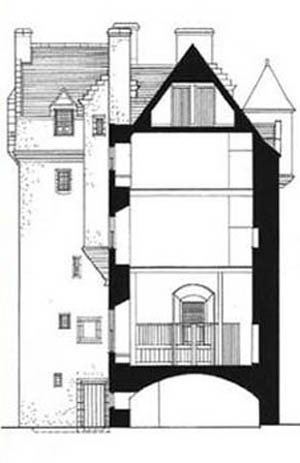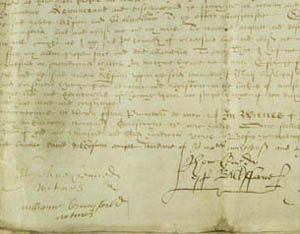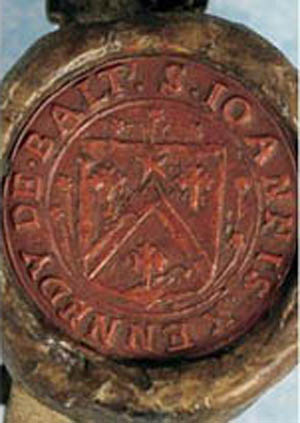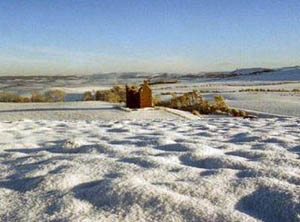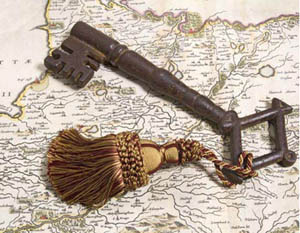|
|
Baltersan Castle is for sale. This 16th-century tower-house lies just six miles from Turnberry and 25 minutes from Scotland's other west-coast Open Championship course at Royal Troon. Designed for one of the Kennedy clan gentry, Baltersan is still ranked among the aristocracy of Scottish Renaissance buildings. Work is ready to start on its restoration as a private country residence. The castle has Full Planning & Listed Building Consents for reconstruction as tourist accommodation; Asking price: US $250,000 |
 |
|||||||||||||||||||||||||||||||||||||||||||||||||||||||||
|
The project could benefit from an Historic Scotland grant of up to GBP500,000, covering about one-quarter of reconstruction costs. The restoration already has had Listed Building Consent as a Category-A building, and Full Planning Consent. Baltersan is on Historic Scotland's list of "most desirable restoration projects". Originally built at the heart of a small estate, Baltersan Castle was elegantly designed as a place of safety, hospitality and business. Its proportions, while generous, are still on a human scale. Rebuilt, it could serve as a five-bedroom family residence, a second home, or a holiday retreat for a group of joint owners to share throughout the year. The present reconstruction plans envisage a revival of the old ground-floor kitchen and first-floor great hall, with library/sitting room, three en-suite bedrooms, plus two other bedrooms, each with its private bathroom. Could Baltersan become YOUR Scottish castle home? If you are right person to build and live the dream, a beautiful, welcoming property awaits in a near-perfect location. Offers for the purchase of the castle are invited either from individuals or a consortium able to raise the finance to turn the ruin back into a coveted luxury residence. Nearly all the groundwork has been prepared, including research, architectural drawings, quantity surveys and cost plans. Vitally, the restoration has Full Planning Consent Planning Consents 08, and had won a grant offer worth around 25% of the rebuild budget. This could be available to a new owner, subject to conditions. Also James Brown, the owner who has taken Baltersan to this stage, is willing to offer his expertise to new owners as project consultant. For these reasons, we recommend that you buy the company, Lichtsome Hoose Ltd as well as the castle (the price is the same). It would be an uncomplicated purchase as the company has no employees, has a single purpose (restoration of the castle) and only one major tangible asset, the castle. There are also tax advantages (both corporation and VAT) to be had by taking over the company.
Baltersan was once the principal house of a small estate. It was a family home, a centre of commercial activity and a place of convivial hospitality. It can be those things again. Plans have been drawn up for spacious accommodation that would be equally serviceable as a private residence or a holiday home for 10. The total floor area (excluding circulation space) is around 250m2 (300yd2). While the layout reflects what we know of the 16th c. arrangement, it's also intended to offer 21st c. comforts - not least in plumbing and heating! Four winding staircases will act as vertical corridors to the five floor levels, lending a special sense of privacy to the five bed-chambers. And the Great Hall (Level 2) will again become the heart of the home - a magnificent Scots Renaissance banqueting hall.
Level 1 - Kitchen, utility room, WC, food and goods hoistsA Entrance B Kitchen with Cold Room and dumb waiter (food hoist) to the Great Hall. C Utility room with W.C. D Goods hoist to all 5 levels 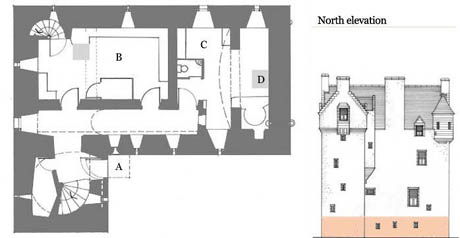 Floor areas: B 27.2 m2 (293 ft2) C 14 m2 (150.7 ft2)
Level 2 - Great Hall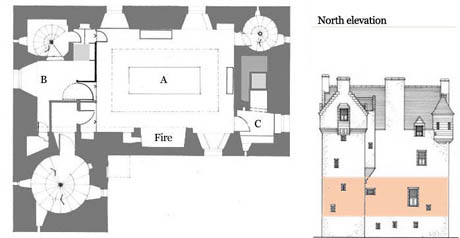
A Great Hall with extendable table to seat 12 - 14 guests. There will be adequate room to set a banquet for more if required on special occasions. B Service area with dumb waiter (food hoist) from the Kitchen. C Storage area with access to the goods hoist serving 5 levels. Floor areas: A 44.7 m2 (481 ft2) B 8 m2 (86 ft2)
Level 3 - Library, Bed-chamber 1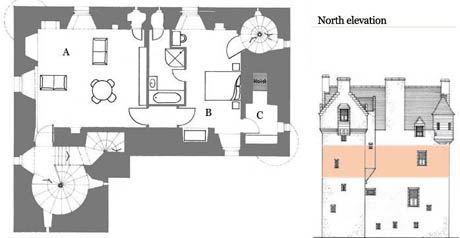
A Withdrawing room / Library B Bed-chamber 1: twin or double with en-suite bathroom C Storage area with access to the goods hoist serving 5 levels Floor areas: A 33 m2 (355 ft2) B 30 m2 (323 ft2)
Level 4 - Bed-chambers 2-4
A Bed-chamber 2: twin or double with en-suite bathroom B Bed-chamber 3: twin or double with en-suite bathroom C Bed-chamber 4: twin or double (W.C. and shower on Level 5) H Goods hoist to all 5 levels
Floor areas: A 39 m2 (420 ft2) B 36.3 m2 (391 ft2) C 13 m2 (140 ft2)
Level 5 - Bed chamber 5, off-suite shower-room, storage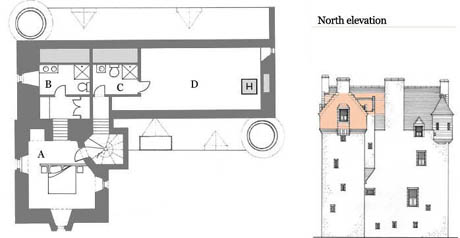
A Bed-chamber 5: twin or double Floor area: 31.7 m2 (293 ft2) B En-suite W.C. and shower for bed-chamber 5 C Private W.C. and shower for bed-chamber 4 (Level 4) D Storage and access to goods hoist serving all 5 levels
ArchitectureBaltersan is a Category A-Listed building putting it in the top 8% of Scotland's inventory of historic buildings of high merit. Although a modest tower-house it contains a number of rare and perhaps unique features which justify its listing. On plan, it is a typical L-shape with the main staircase wing in the smaller leg of the L. This was a 16th c. development of the basic keep which, although common throughout Europe, achieved its greatest range of variants in Scotland. By the mid-17th c. country house fashion changed in favour of the horizontal and symmetrical instead of the vertical and asymmetrical. The 15th c. keep was simply a stack of apartments, one above the other with the turnpike stair acting as a vertical corridor. Walls were generally about 6 feet thick (2 metres) but thinned slightly and progressively in each upper floor as less weight had to be borne. By the middle of the 16th c. walls had reduced to four feet thick at lower levels, ground floor cellars were linked by a service corridor and floors above the Hall (piano nobile) were divided into two apartments. Staircase wings and both round and square towers were being added to create a range of ground plans in the general shape of the letters L, T and Z. In the final quarter of the 16th c. masons were excelling themselves in contriving delightful confections of corbelled turrets, caphouses and crowstepped gables, giving us the distinctive Scottish baronial style. This became more and more elaborate, reaching its zenith at Craigievar in Aberdeenshire. Also in that county we find Leslie Castle, recognised as the last tower-house to be built in Scotland, although the Scot's attachment to this building form never died and some have even been built in the last 30 years. Baltersan dates from the middle to the last quarter of the 16th c. Perhaps a deeper study of charter evidence will yield the key sentence that will allow a more positive dating. Considering that it was the home of a Guidman (rank below a Laird) who owned a comparatively small estate, it has a quality of carved stonework rarely found in a building of this scale. Profiles of these moulded stones were made by the Royal Commission on the Ancient and Historic Monuments of Scotland (RCAHMS) and may be examined at their Edinburgh offices along with photographs of Baltersan. Two of the most remarkable features of Baltersan can be found at the third level which would have housed the principal bed chambers. In the south-east corner is a fireside (ingleneuk) seat which caught the attention of Charles Rennie Mackintosh in 1895. Next to it is a window, one of two large windows in the south wall, which once had sliding shutters. Because all window openings were barred for security, shutters would have had to open inwards. In the case of these two, the shutters slid sideways into the wall thickness. Although a common feature in towns of the period, noticeably Edinburgh, they were placed on the outside walls. The next date that this architectural device is encountered in Scotland is in a sea captain's 18th c. house in Dundee. Baltersan was inhabited by a sea captain in the 1750s, Hugh Arbuthnot whose family name was strongest in the region north of Dundee. Was there a connection?
Gardens & LandscapeThe four acres of land around Baltersan earmarked for the development are presently laid out to crops and grazing. We know that historically there were gardens and orchards there when the castle was the main house of a small estate. Indeed, we even know the name of John Kennedy's gardener at Baltersan in the 16th century, one John MacMillan who died there in July, 1621. 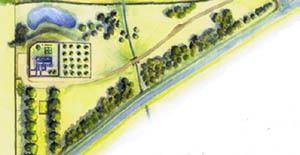
As in all country houses, the gardener was one the two most important members of staff; the other being the cook who would rule the kitchen. Such was John MacMillan's importance that he was able to leave a Will with several legacies. What we do not know is what he grew in his garden, but we can have a fair idea from a 1559 inventory of the Castle of Sanquhar-Hamilton in Ayr ... "2 large orchards and yards having 3 gates and planted with stands of hawthorn bushes, gooseberry bushes, redcurrant bushes, rose bushes, apple trees, plum trees, cherry trees, wild plum trees, almond trees, plane trees, birch trees, ash, hawthorn and other trees and provided with two ponds and enclosed by a stone wall, capped with lime." Further evidence comes from Timothy Pont's 16th c. description of Baltersan as ... "A stately fine house with gardens, orchards, parks and woods about it ..." Moving forward one hundred years we find John Reid publishing Scotland's first gardening book, from which comes the quotation in the picture above. We have the rare opportunity three centuries later to re-discover a truth our ancestors knew all too well. Charter evidence for Baltersan's orchards is contained in a Precept of Clare Constat by Alan, Commendator of Crossraguel, dated 28th March, 1574; "The three merkland of Baltersan of old extent, with mansion and orchards, with a piece of meadow lying behind the said mansion on one side and the Lands of Dalchomie on the other side, and the meadow formerly called Lady of Row's meadow." Baltersan is inextricably linked with the nearby Mediæval abbey of Crossraguel (illustrated above with Baltersan in the right middleground) and the Kennedies. In its ruined state it caught the attention of John Slezer, Francis Grose, Robert Burns, Robert Adam, John Clerk of Eldin (whose etching is shown above), John Keats, James Nasmyth, Robert Louis Stevenson, and Charles Rennie Mackintosh. They are all described in some detail on the Famous Visitors page. In 1721 the estate passed into the hands of Captain Hugh Arbuthnot, cousin to John Kennedy of Baltersan. It seems that by the middle of the 18th c. the house was abandoned and has lain in ruins ever since. It was bought in the late 19th c. by Peter Sturrock, ex-Provost of Kilmarnock. He intended restoring the place but the plan did not come to fruition. By the end of the 20th century with Baltersan back in Kennedy ownership as part of the Culzean & Cassillis estates, it came to the notice of James Brown. James's love affair with Scottish castles started at the age of five. The youngest of eight brothers raised in a three-room tenement flat in post-war, East-end Glasgow, James was taken on a seaside excursion to Ayrshire. From his first sighting there of Ardrossan Castle, he was captivated. It became a life-long ambition to have and nurture a castle of his own. When he set eyes on Baltersan in 1989 James had visited more than 100 historic buildings described in The Castellated and Domestic Architecture of Scotland, the definitive five-volume inventory of Scotland's castles, chateaux and tower-houses by the Victorian architects, MacGibbon and Ross. It was not on the market but he offered to buy it only to be out-bid by a speculative castle-hunter. A few years later, Baltersan suddenly appeared on the open market. Its new owner had gone bust. In the face of hundreds of hopefuls who applied for sales details, James held his nerve, sold the flat he had bought only weeks earlier, and bought the castle. The aim was to restore it to its former glory. By running Baltersan as luxury holiday accommodation, it could be shared with others while earning its upkeep. A company was set up to hold the castle and safeguard the restoration process; Lichtsome Hoose Ltd. But 1996 saw a major setback; planning officials recommended refusal of James's application to restore the castle. They had been told by archæologists the development would 'interfere with standing archæology'. The news brought a barrage of protest from supporters world-wide - among them the author Nigel Tranter and architectural historian, Professor Charles McKean. The recommendation was overturned. But five years later renewal of Planning Consent was refused when the Scottish Executive Roads Department claimed that the development 'would bring too much traffic on to the A77 road'. Again a world-wide campaign was launched and this decision was overturned. Crucially, a positive and supportive relationship has been established with the planning authority and Historic Scotland, the nation's heritage watchdog. The architect's plans drawn up in 1995 by ARP Lorimer of Ayr were developed further by Morris & Steedman Associates (then known as Ian Begg, Architects) and the long quest for investment began. Meantime, James rented a nearby farm cottage and started to clear the castle ruin of rubble and soil accumulated over 250 years. It was painstaking work To preserve each artefact of potential archæological interest, James worked with just a spade, shovel, wheelbarrow and a claw hammer as a mattock. Single-handed, he removed 1,000 tonnes of reusable masonry by wheelbarrow and archived hundreds of artefacts. Meantime, he was elected a Fellow of the Society of Antiquaries of Scotland for his research on Baltersan's history.
The KennedysSuch was the extent of Kennedy power in south-west Scotland that at their peak, various branches of the family owned about 40 estates between Ayr and the Solway Firth. As in any country, disputes, quarrels and blood feud were not uncommon. The low point was the notorious set-piece conflict at Pennyglen, by Maybole in 1600 when 200 men supporting the Earl of Cassillis engaged with about 80 supporters of the Kennedy Laird of Bargany. Young Bargany died of wounds soon after and within a few years his family's estate fell into terminal decline. The present house of Bargany dates from the late 17th c. but the young laird's elaborate memorial can be seen in the village of Ballantrae. A reprisal by Bargany's men about six months later resulted in the murder of Sir Thomas Kennedy of Culzean in the woods of St Leonard's, Ayr. Sir Thomas, whose portrait can be seen in Culzean Castle, was half-brother to John Kennedy of Baltersan and had spent his last night alive in the company of Baltersan at his seaside villa of Greenan. That ruined tower-house still stands, perched precariously at the very edge of a 100 feet high sea-cliff. The Kennedy name is first recorded in connection with Baltersan in the late 15th c. when James Kennedy, Lord of Row, settled there with his wife, Egidia Blair, daughter of John Blair of that Ilk. In 1498 their niece, Janet Kennedy started a long affair with King James IV, becoming his favourite mistress. Egidia Blair, Lady Row of Baltersan was a pious and generous woman. We are fortunate in having a copy of her last Will and Testament of 1530 which lists many legacies to local people and to Crossraguel Abbey. Her tombstone can still be seen there. One of her executors was David Kennedy of Pennyglen, a farm near Dunure, about 6 miles from Baltersan. He later lived at Baltersan, although it is not certain if this was at Lady Row's former dwellinghouse or the tower-house we see today. David's illegitimate son John was born about 1539 to Margaret Kennedy, widow of William Wallace of Craigie and soon after John's birth, wife of Gilbert Kennedy, 3rd Earl of Cassillis. David acted for years as attorney to the 3rd Earl. John continued the closeness with his half-brothers at Cassillis throughout his life although it would have been a most difficult time during the feud mentioned above for his son-in-law took the field in 1600 for the Earl and his brother-in-law, Cathcart of Carleton, led the troops on Bargany's side. Illustrated above is a charter involving Kennedy in a Berwickshire land deal. One of the witnesses is David Dicksoun, "comptour wardane" of the Royal Mint in Edinburgh. Kennedy handled numerous land deals in his life as the Register of Sasines shows. But he was also disputatious. Notably with the Burgesses of Ayr over non-payment for his salmon fishing rights on the River Doon at Alloway. He extended the family estate by adding several farms between Baltersan and the coast and he died in February, 1609 at The Greenan (now known as Greenan Castle). The charter and seal are reproduced by kind permission of Edinburgh University Special Collections Department. They form part of the Laing Charters (ref. 164). It could be his portrait and that of one of his wives (he had three marriages) and perhaps his son and heir that we see on the oak panels in the Flash sequence shown on the Home page. His son John was a servant to King James VI (who became James I of England) and for a period was commendator of Soulseat Abbey in Galloway. In the charter above the younger John signed as a witness. His title Mr and his fine calligraphic hand mark him out as an educated man. Note the slightly different spelling of the name John. This was deliberate to distinguish between father (Jhone) and son (Johne). In 1622 Alexander Kennedy acquired the estate of Culzean and twenty years later bought Baltersan. He settled his son Thomas there and it is probable that Thomas, a major in the Army of the Covenant, gave protection to the fugitive Presbyterian preacher, Alexander Peden in the 1660s when Peden held open-air gatherings for worship by a thorn tree on Mains of Baltersan farm. The last Kennedy to reside at Baltersan was also called John. He died "abroad in London" as his Testament tells us, in August, 1721. The estate passed to his cousin, Captain Hugh Arbuthnot. |
|
|||||||||||||||||||||||||||||||||||||||||||||||||||||||||
|
|
||||||||||||||||||||||||||||||||||||||||||||||||||||||||||
| :::: Link to us :::: Castle and Manor Houses Resources ::: © C&MH 2010-2014 ::: contact@castlesandmanorhouses.com ::: |
